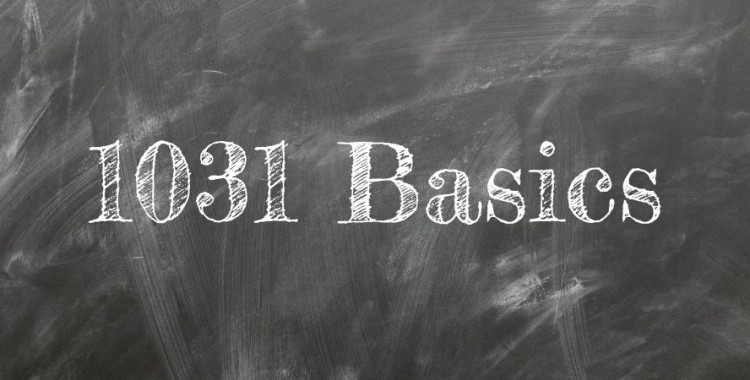The Basics of a 1031 Exchange
Here, we discuss a Section 1031 Exchange used for investment or business purposes (note: this is not applicable if used as a primary residence).
Basic Rule: IRC Section 1031 provides an exception and allows you to postpone paying tax on the gain if you reinvest the proceeds in similar property as part of a qualifying like-kind exchange. Gain deferred in a like-kind exchange under IRC Section 1031 is tax-deferred, but it is not tax-free.
What all of this means in plain English: if you are selling an investment property at a gain, consider using a 1031 facilitator to defer gains. If you are young, it will save a lot in taxes. If you are older, your heirs will get a step-up and take the property tax free upon your passing.
Who qualifies for a 1031 Exchange?
Owners of investment and business property may qualify for a Section 1031 deferral. Individuals, C corporations, S corporations, partnerships (general or limited), limited liability companies, trusts, and any other taxpaying entity may set up an exchange of business or investment properties for business or investment properties under Section 1031.
What are the different structures of a 1031 Exchange?
To accomplish a Section 1031 Exchange, there must be an exchange of properties. The simplest type of a 1031 Exchange is a simultaneous swap of one property for another.
Deferred exchanges are more complex, but allow flexibility. They allow you to dispose of property and subsequently acquire one or more other like-kind replacement properties.
To qualify as a Section 1031 Exchange, a deferred exchange must be distinguished from the case of a taxpayer simply selling one property and using the proceeds to purchase another property (which is a taxable transaction). Rather, in a deferred exchange, the disposition of the relinquished property and acquisition of the replacement property must be mutually dependent parts of an integrated transaction constituting an exchange of property. Taxpayers engaging in deferred exchanges generally use exchange facilitators under exchange agreements pursuant to rules provided in the Income Tax Regulations.
A reverse exchange is somewhat more complex than a deferred exchange. It involves the acquisition of replacement property through an exchange accommodation titleholder, with whom it is parked for no more than 180 days. During this parking period the taxpayer disposes of its relinquished property to close the exchange.
What type of property qualifies for a like-kind exchange?
Both the relinquished property you sell and the replacement property you buy must meet certain requirements. Both properties must be held for use in a trade or business or for investment. Note: Property used primarily for personal use, like a primary residence or a second home or vacation home, does not qualify for like-kind exchange treatment.
What is like-kind property?
Like-kind property is property of the same nature, character or class. Most real estate will be like-kind to other real estate. For example, real property that is improved with a residential rental house is like-kind to vacant land. One exception for real estate is that property within the United States is not like-kind to property outside of the United States. Also, improvements that are conveyed without land are not of like kind to land.
What are the time limits to complete a Section 1031 deferred like-kind exchange?
While a like-kind exchange does not have to be a simultaneous swap of properties, you must meet two time limits or the entire gain will be taxable. These limits cannot be extended for any circumstance or hardship except in the case of Presidentially declared disasters.
First time crunch. You have 45 days from the date you sell the relinquished property to identify potential replacement properties.
The identification must be in writing, signed by you and delivered to a person involved in the exchange like the seller of the replacement property or the qualified intermediary. However, notice to your attorney, real estate agent, accountant or similar persons acting as your agent is not sufficient.
Replacement properties must be clearly described in the written identification. In the case of real estate, this means a legal description, street address or distinguishable name.
Second time crunch. Whichever of the following two options is earlier: 1) the replacement property must be received and the exchange completed no later than 180 days after the sale of the exchanged property, or 2) the due date (with extensions) of the income tax return for the tax year in which the relinquished property was sold. The replacement property received must be substantially the same as property identified within the 45-day limit described above.
Restrictions for deferred and reverse exchanges?
Taking control of cash or other proceeds before the exchange is complete may disqualify the entire transaction from 1031 treatment and make all gains immediately taxable.
If cash or other proceeds that are not like-kind property are received at the conclusion of the exchange, the transaction will still qualify as a like-kind exchange. Gain may be taxable, but only to the extent of the proceeds that are not like-kind property.
One way to avoid premature receipt of cash or other proceeds is to use a qualified intermediary or other exchange facilitator to hold those proceeds until the exchange is complete.
Note: You cannot act as your own facilitator. In addition, your agent (including your real estate agent or broker, investment banker or broker, accountant, attorney, employee or anyone who has worked for you in those capacities within the previous two years) cannot act as your facilitator.
How do you compute the basis in the new property?
The basis of property acquired in a Section 1031 Exchange is the basis of the property given up with some adjustments. This transfer of basis from the relinquished to the replacement property preserves the deferred gain for later recognition. A collateral effect is that the resulting depreciable basis is generally lower than what would otherwise be available if the replacement property were acquired in a taxable transaction.
When the replacement property is ultimately sold (not as part of another exchange), the original deferred gain, plus any additional gain realized since the purchase of the replacement property, is subject to tax.
How do you report Section 1031 like-kind exchanges to the IRS?
You must report an exchange to the IRS on Form 8824 for like-kind exchanges and file it with your tax return for the year in which the exchange occurred.
Form 8824 asks for:
- Descriptions of the properties exchanged
- Dates that properties were identified and transferred
- Any relationship between the parties to the exchange
- Value of the like-kind and other property received
- Any gain or loss on the sale of other (non-like-kind) property given up
- Cash received or paid; liabilities relieved or assumed
- Adjusted basis of like-kind property given up; realized gain
What if I have a loan on this property?
A taxpayer must not receive boot* from an exchange in order for a 1031 Exchange to be completely tax-free. Any boot received is taxable (to the extent of gain realized on the exchange). This is okay when a seller desires some cash and is willing to pay some taxes. Otherwise, boot should be avoided in order for a 1031 Exchange to be tax free.
*What is “boot”?
Boot is the “money” or the fair market value of “other property” received by the taxpayer in an exchange, where: “money” is all cash plus liabilities assumed by the other party, or liabilities to which the property exchanged by the taxpayer is subject to; and “other property” is property that is non-like-kind, such as personal property received in an exchange of real property, property used for personal purposes, or “non-qualified property.” Other property also includes such things as a promissory notes received from a buyer (also known as Seller Financing).
Boot can be inadvertent and result from a variety of factors. It is important for a taxpayer to understand what can result in boot if taxable income is to be avoided. The most common sources of boot include the following:
- Cash boot received during the exchange. This will usually be in the form of “net cash received” at the closing of either the relinquished property or the replacement property.
- Debt reduction boot. This occurs when a taxpayer’s debt on replacement property is less than the debt which was on the relinquished property. Debt reduction boot can occur when a taxpayer is “trading down” in the exchange.
Excess borrowing to acquire replacement property. (Taking a larger loan and receiving cash). Borrowing more money than is necessary to close on replacement property will cause cash being held by an Intermediary to be excessive for the closing. Excess cash held by an Intermediary is distributed to the taxpayer, resulting in cash boot to the taxpayer. Taxpayers must use all cash being held by an Intermediary for replacement property. Additional financing must be no more than what is necessary, in addition to the cash, to close on the property.
Loan acquisition. Costs with respect to the replacement property which are serviced from exchange funds being brought to the closing. Loan acquisition costs include origination fees and other fees related to acquiring the loan. Taxpayers usually take the position that loan acquisition costs are being serviced from the proceeds of the loan. However, the IRS may take a position that these costs are being serviced from Exchange Funds. This position is usually the position of the financing institution also. There is no guidance in the form of Treasury Regulations on this issue at the present time which is helpful.
Boot Offset Rules. Only the net boot received by a taxpayer is taxed. In determining the amount of net boot received by the taxpayer, certain offsets are allowed and others are not (as follows)…
- Cash boot paid offsets cash boot received (but only at the same closing table).
- Debt incurred on the replacement property offsets debt-reduction boot received on the relinquished property.
- Cash boot paid offsets debt – reduction boot received.
- Debt boot paid never offsets cash boot received (net cash boot received is always taxable).
- Exchange expenses (transaction and closing costs) paid (relinquished property and replacement property closings) offset net cash boot received.
General Rules of Thumb
- Always trade “across” or up. Never trade down (the “even or up rule”). Trading down always results in boot received, either cash, debt reduction or both. The boot received can be mitigated by exchange expenses paid.
- Bring cash to the closing of the relinquished property to cover charges, which are not transaction costs (see above).
- Do not receive property which is not like-kind.
- Do not over-finance replacement property. Financing should be limited to the amount of money necessary to close on the replacement property in addition to exchange funds, which will be brought to the replacement property closing.







